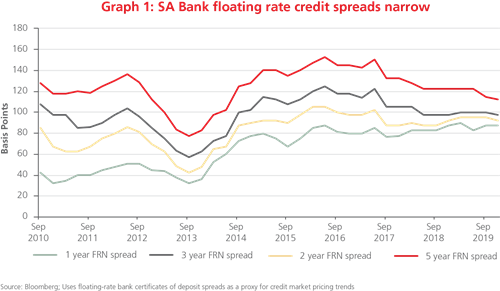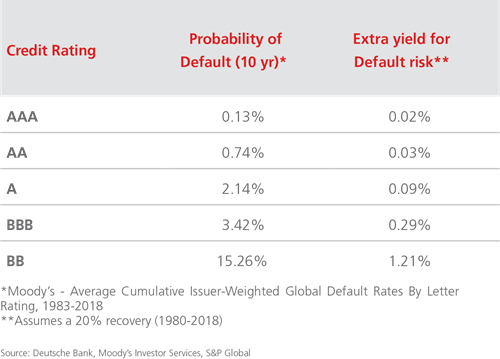Is SA corporate credit too expensive?
Article Summary
Gareth Bern, Head of Fixed Income, argues that, despite the fall in yields available from corporate debt in recent years, these instruments can still add value to investor portfolios.
- Some investors are arguing that SA’s corporate credit – particularly floating-rate notes – has become too expensive as yields have fallen steadily in the past four years and no longer offer attractive potential returns for the risk involved.
- We believe that this timeframe doesn’t reflect an accurate picture, since four years ago yields were exceptionally high. Currently 10-year bank FRN spreads are actually trading around their 10-year average.
- There are differences in the market among various issuers – highly rated companies have become even more expensive than their lower-rated counterparts. The narrowing of credit spreads can be attributed to new regulations requiring banks to hold more highly rated debt, as well as to improved liquidity
- We see an opportunity in one-year bank FRNs that are offering attractive yields vs the risk involved.
Prudential has always seen corporate credit as a core asset class within the fixed income investment universe, since it can add value to our clients’ portfolios through the extra yield (or spread) it offers – but only where appropriate for the risk involved. We take pride in our robust credit research process, which we have followed for nearly 20 years. This reflects a similar investment focus on credit as that of our largest shareholder, M&G Investments, which runs one of the larger European credit investment teams. We have been active in the local credit market from its inception in the early 2000s, successfully navigating the Global Financial Crisis (GFC) in 2008 and other difficult periods, to today.
There is currently a debate in the local investment industry over floating-rate corporate credit (in the form of floating-rate notes or FRNs), and whether this debt has become too expensive, particularly for higher-quality issuers. This would mean that the yield these assets now offer is insufficient for the risk involved. Low- to medium-risk unit trust funds, which have benefitted from strong investment inflows over the last few years, have been particularly active in deploying these new investment inflows into this part of the fixed income market.
Prudential’s view
At Prudential, we do not believe local floating rate credit is currently expensive. This is despite the fact that, in the past four years, the extra yield (or “spread”) offered by FRNs has fallen (as shown in Graph 1), no longer providing as much additional compensation as it did previously. In analysing this move it is important to provide some historic context, and in particular to consider the starting point of the analysis. We think this historic context is important, as most discussions around “how expensive credit is” appear to be anchored to the market’s experience over the last four years.
Looking back six years ago, in 2014, South Africa’s fixed income market had suffered a significant repricing in interest rates and spreads from the lows experienced in 2013. First had come a sharp sell-off in April 2013 across most global markets of bonds and other shorter-dated notes and loans, in what has been termed the global “taper tantrum” (sparked by US Federal Reserve Chairman Ben Bernanke saying the US planned to start removing monetary support for the economy). Then in September 2014, the local market experienced the largest South African capital market default ever – African Bank. This further exacerbated the sell-off and pushed spreads even higher in the 18 months thereafter, as clearly shown in the graph. We would argue that the debate around the level of credit spreads within the context of the last four years fails to take into account the particularly elevated starting level of spreads given the market context.
In fact, the longer 10-year period depicted by Graph 1 highlights that currently bank credit spreads look to be trading around their 10-year average levels. It’s also worth noting that they are significantly above their pre- GFC levels. So while it is true that spreads have tightened and yields have compressed, particularly over the last three years, in a longer-term context they do not look expensive.
Graph 1: SA Bank floating rate credit spreads narrow 
Extra yield vs extra default risk
It is important to consider what spread investors should earn to compensate for the risk of default. As most will know, South Africa has suffered a series of sovereign credit rating downgrades in the past two years, and some South African corporate ratings have also been lowered, due largely to the weak economic environment. Investors should consider how much more yield they require as compensation for the increased risk of default by companies. The below table shows what spread (extra yield) investors should require to compensate for the risk of default, based on the historical default experience in the US market at the 10-year tenor point.
Table 1
With South African bank debt rated BBB by Moody’s, this 0.29% additional yield should be reflected in our bank FRN spreads. Currently, these spreads are around 1.50%-1.60%, significantly higher than the table would suggest investors should require. Clearly, investors also need to be compensated for additional risks such as volatility and the lower liquidity (or tradability) of corporate credit, but these figures do put the spreads available to investors into context.
It is also worth highlighting that at an individual issuer level there can be borrowers whose credit is expensive and those whose credit is cheap. At Prudential we are very selective – we can point to a number of examples where we have not bid on individual corporate issues because we felt the spread on offer was not compelling enough. There are also occasions where we have bid at a higher spread than the market clearing price because our analysis indicated that a higher level was appropriate for the risk.
Examples of corporate credit that has become expensive and where spreads have fallen in the past five years include highly rated borrowers like Toyota and Mercedes Benz. Because their credit ratings are above that of South Africa’s own sovereign rating, reflecting their foreign owners’ creditworthiness, they have always been highly sought-after. But in the past five years their spreads have narrowed even further – partly because regulations have encouraged banks to hold these instruments and have led banks to become more active in the credit market. The latter has made this market somewhat more liquid than in the past, helping reduce the extra yield investors require for a lack of liquidity. Arguably, the lower spreads that have been observed are as much a function of improved liquidity as anything else.
Opportunity in one-year bank FRNs
One area of the market which does appear to offer a buying opportunity based on their relative value is one-year bank FRNs, where yields still remain elevated compared to their history. We ascribe this to the regulatory changes introduced within the banking sector following the GFC. These changes, amongst others, have encouraged banks to lengthen the term of their wholesale funding, which has served to keep the one-year tenor elevated versus history. We expect this effect to be an enduring feature of the local market. As such, within our various funds like the Prudential Income and Enhanced Income Funds we have sought to take advantage of this phenomenon and continued to add exposure to this area of the curve.
The Prudential Income Fund, now with its three-year performance track record, has certainly benefited from this FRN exposure, having outperformed its benchmark (the STeFI Composite Index) with a return of 8.6% p.a. vs 7.4% p.a. since its inception in December 2016.
In conclusion, it takes the careful, consistent application of a robust credit investment process to uncover the opportunities in the corporate credit market that can help to add value to our clients’ portfolios. For us, the focus is on whether the value justifies the risk involved. Over the past two decades this valuation-based process has proved its worth, through all market cycles.
For more information please feel free to contact our Client Services Team on 0860 105 775 or email us at query@prudential.co.za.
|
The FRN market in South Africa In South Africa, FRNs make up about 16% of the total primary debt listings on the JSE. FRN issuance is mostly dominated by the “big four” banks, while also including companies as diverse as Netcare, Mercedes Benz South Africa and property companies. The South African government, unlike many other emerging market governments, does not issue FRNs, although some state-owned enterprises (SOEs) and municipalities do. In the local market, FRN coupons are set based on the three-month Johannesburg Interbank Agreed Rate (JIBAR), which, simplistically, is the average of South African banks’ three- month interest rates. The FRN issuer pays a margin above JIBAR that reflects the risk lenders believe is inherent in the note, with the margin determined by factors including the issuer’s credit risk (based on its credit rating), the length of the loan (also called the ‘term’) and the liquidity of the instrument (how easily it is traded). The poorer the credit rating, longer the loan, and lower the liquidity, the higher the margin (or spread) above JIBAR. So how does it work? Suppose that a company wants to borrow R150 million over three years. It issues a R150 million three-year FRN with a coupon of three-month JIBAR plus 200 basis points (bps), or 2.00%. Initially three-month JIBAR is 6.6%, so the coupon paid by the company is 8.6%. Every quarter thereafter the coupon adjusts to reflect the prevailing JIBAR at that time. For instance, if after 3 months three-month JIBAR rises to 7.1%, the coupon will be re-set, increasing to 9.1% for the next three-month period. |
Share
Did you enjoy this article?
 South Africa
South Africa Namibia
Namibia




 Get the Newsletter
Get the Newsletter